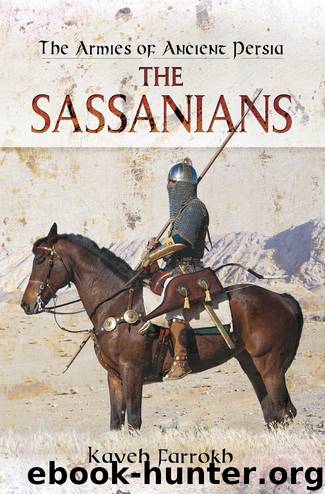The Armies of Ancient Persia by Kaveh Farrokh

Author:Kaveh Farrokh
Language: eng
Format: epub
Tags: HISTORY / Ancient / General
ISBN: 9781473883185
Publisher: Pen and Sword
Published: 2014-02-28T05:00:00+00:00
Yazdegird II and The Kidarites
Soon after the pacification of the Central Asian frontiers, the Sassanians faced a new threat. By the 440s CE, the Kidarites (also known as Cbuls68) had crossed the Oxus and proceeded to attack Khorasan as well as Khwarezm farther north of Khorasan. The attacks were especially harsh as they involved looting, destruction and the capture of the empire’s citizens to be carried off as slaves. The shahanshah, Yazdegird II (r. 438–457) and the military leadership convened the war council to discuss strategies for defeating these new threats to the empire’s eastern domains.
A force of the savaran had been dispatched towards Nev-Shapur (Nishabur) along the eastern frontiers to face the Kidarite threat by 443 CE, but no decisive battle appears to have taken place. Instead, the Sassanians proceeded to build up massive walls at Gorgan and Khorasan (the walls of Tammisha and Gorgan, see Chapter 13). This proved to be a careful and prudent strategy, as Tammisha and Gorgan acted as powerful fortified bases for the assembly of savaran forces prior to undertaking offensives into Kidarite occupied territory. The war council had apparently ruled against a single ‘all-out’ offensive in favour of a series of carefully planned offensives that slowly unfolded in stages. Such tactics were possibly meant in part to assess the strengths and weaknesses of the Kidarites.
The phased offensives bore fruit seven years later to the extent that by 450 CE the spah had expelled the Kidarites from Sassanian territory. What remains unclear are the specific military details of the final battles against the Kidarites. At first glance it is possible to speculate that a combination of savaran lance charges, archery and close-quarters combat were the major factors in the spah’s successes. Although the Kidarites were heirs to a long Central Asian cavalry tradition, the Sassanians may have employed superior tactics that tipped the balance in their favour. However, the exact nature of Sassanian tactics cannot be ascertained.
Following these successes, Yazdegird II built the fortress-city of Shahrestan-e Vuzurg (literally ‘greater city’ or ‘locale’), which most likely was integrated into the fortress systems of the Gorgan Wall. Nevertheless, the Kidarites were far from finished. They retained the core of their military strength and continued to launch ‘raid-and-run’ attacks into Iranian territory, forcing Yazdegird to continue his campaigns against them to the latter days of his life. The Kidarite threat would be inherited by Yazdegird II’s successor, Pirouz.
Download
This site does not store any files on its server. We only index and link to content provided by other sites. Please contact the content providers to delete copyright contents if any and email us, we'll remove relevant links or contents immediately.
| Africa | Americas |
| Arctic & Antarctica | Asia |
| Australia & Oceania | Europe |
| Middle East | Russia |
| United States | World |
| Ancient Civilizations | Military |
| Historical Study & Educational Resources |
The Daily Stoic by Holiday Ryan & Hanselman Stephen(2708)
The Fate of Rome: Climate, Disease, and the End of an Empire (The Princeton History of the Ancient World) by Kyle Harper(2436)
People of the Earth: An Introduction to World Prehistory by Dr. Brian Fagan & Nadia Durrani(2346)
Ancient Worlds by Michael Scott(2102)
Babylon's Ark by Lawrence Anthony(2070)
Foreign Devils on the Silk Road: The Search for the Lost Treasures of Central Asia by Peter Hopkirk(2056)
India's Ancient Past by R.S. Sharma(1987)
MOSES THE EGYPTIAN by Jan Assmann(1972)
The Complete Dead Sea Scrolls in English (7th Edition) (Penguin Classics) by Geza Vermes(1840)
Lost Technologies of Ancient Egypt by Christopher Dunn(1797)
The Daily Stoic by Ryan Holiday & Stephen Hanselman(1768)
The Earth Chronicles Handbook by Zecharia Sitchin(1744)
24 Hours in Ancient Rome by Philip Matyszak(1677)
Alexander the Great by Philip Freeman(1647)
Aztec by Gary Jennings(1545)
The Nine Waves of Creation by Carl Johan Calleman(1520)
Curse Tablets and Binding Spells from the Ancient World by Gager John G.;(1510)
Before Atlantis by Frank Joseph(1483)
Earthmare: The Lost Book of Wars by Cergat(1466)
